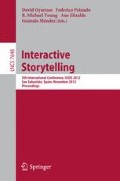Abstract
Computer-based highly interactive drama involves different authoring approaches, compared to linear media. Underlying design principles needs to be understood in order to guide the authoring process, to teach authors and to design better systems. This paper identifies a fundamental design principle termed Structural Writing that underlies some of the most generative approaches in interactive drama. A theoretical description of this principle is proposed, which leads to a general architecture for interactive drama that may help authors and researchers to design systems that better exploit the principle of structural writing.
Access this chapter
Tax calculation will be finalised at checkout
Purchases are for personal use only
Preview
Unable to display preview. Download preview PDF.
References
Aylett, R., et al.: Unscripted narrative for affectively driven characters. IEEE Journal of Graphics and Animation 26, 42–52 (2006)
Barthes, R.: Introduction à l’analyse structurale des récits. Communications 8(1), 1–27 (1966)
Cavazza, M., Charles, F., Mead, S.J.: Characters in Search of an Author: AI-Based Virtual Storytelling. In: Balet, O., Subsol, G., Torguet, P. (eds.) ICVS 2001. LNCS, vol. 2197, pp. 145–154. Springer, Heidelberg (2001)
Ciarlini, A.E.M., Camanho, M.M., Dória, T.R., Furtado, A.L., Pozzer, C.T., Feijó, B.: Planning and Interaction Levels for TV Storytelling. In: Spierling, U., Szilas, N. (eds.) ICIDS 2008. LNCS, vol. 5334, pp. 198–209. Springer, Heidelberg (2008)
Eco, U.: Lector in fabula: Le rôle du lecteur ou la Coopération interprétative dans les textes narratifs. Grasset, Paris (1985)
Egri, L.: The art of dramatic writing. Simon & Shuster, New York (1946)
Fairclough, C.R.: Story Games and the OPIATE System. University of Dublin, Trinity College (2004)
Field, S.: Screenplay – The Foundations of Screenwriting. Dell Publishing, New York (1984)
Greimas, A.J.: Sémantique structurale, Presses universitaires de France, Paris (1966)
Lavandier, Y.: La dramaturgie. Le clown et l’enfant, Cergy, France (1997)
Levi-Strauss, C.: Anthropologie Structurale. Plon, Paris (1958)
Louchart, S., Aylett, R.S., Dias, J.: Double Appraisal for Synthetic Characters. In: Pelachaud, C., Martin, J.-C., André, E., Chollet, G., Karpouzis, K., Pelé, D. (eds.) IVA 2007. LNCS (LNAI), vol. 4722, pp. 393–394. Springer, Heidelberg (2007)
Murray, J.H.: Why Paris Needs Hector and Lancelot Needs Mordred: Using Traditional Narrative Roles and Functions for Dramatic Compression in Interactive Narrative. In: Si, M., Thue, D., André, E., Lester, J.C., Tanenbaum, J., Zammitto, V. (eds.) ICIDS 2011. LNCS, vol. 7069, pp. 13–24. Springer, Heidelberg (2011)
Nichols, B.: Ideology and the image. Indiana University Press, Bloomington (1981)
Portugal, J.-N.: L’avenir dira ce que nous aurons créé. In: Szilas, N., Réty, J.-H. (eds.) Création de Récits pour les Fictions Interactives: Simulation et Réalisation, pp. 133–165. Hermes & Lavoisier, Paris (2006)
Propp, V.: Morphologie du conte. Seuil, Paris (1928)
Ryan, M.: Possible Worlds, Artificial Intelligence, and Narrative Theory. Indiana University Press, Bloomington (1991)
Sgouros, N.M.: Dynamic generation, management and resolution of interactive plots. Artificial Intelligence 107(1), 29–62 (1999)
Souriau, E.: Les deux cent mille Situations dramatiques. Flammarion, Paris (1950)
Spierling, U.: Conceiving Interactive Story Events. In: Iurgel, I.A., Zagalo, N., Petta, P. (eds.) ICIDS 2009. LNCS, vol. 5915, pp. 292–297. Springer, Heidelberg (2009)
Spierling, U., Szilas, N.: Authoring Issues beyond Tools. In: Iurgel, I.A., Zagalo, N., Petta, P. (eds.) ICIDS 2009. LNCS, vol. 5915, pp. 50–61. Springer, Heidelberg (2009)
Szilas, N.: A Computational Model of an Intelligent Narrator for Interactive Narratives. Applied Artificial Intelligence 21(8), 753–801 (2007)
Szilas, N., Marty, O., Réty, J.-H.: Authoring Highly Generative Interactive Drama. In: Balet, O., Subsol, G., Torguet, P. (eds.) ICVS 2003. LNCS, vol. 2897, pp. 37–46. Springer, Heidelberg (2003)
Szilas, N.: IDtension: a narrative engine for Interactive Drama. In: Göobel, S., et al. (eds.) Proceedings of the Technologies for Interactive Digital Storytelling and Entertainment (TIDSE) Conference, pp. 187–203. Fraunhofer IRB (2003)
Szilas, N.: Structural models for Interactive Drama. In: 2nd International Conference on Computational Semiotics for Games and New Media, COSIGN (2002)
Young, R.M., et al.: An architecture for integrating plan-based behavior generation with interactive game environments. Journal of Game Development 1(1), 1–29 (2004)
Author information
Authors and Affiliations
Editor information
Editors and Affiliations
Rights and permissions
Copyright information
© 2012 Springer-Verlag Berlin Heidelberg
About this paper
Cite this paper
Szilas, N., Richle, U., Dumas, J.E. (2012). Structural Writing, a Design Principle for Interactive Drama. In: Oyarzun, D., Peinado, F., Young, R.M., Elizalde, A., Méndez, G. (eds) Interactive Storytelling. ICIDS 2012. Lecture Notes in Computer Science, vol 7648. Springer, Berlin, Heidelberg. https://doi.org/10.1007/978-3-642-34851-8_7
Download citation
DOI: https://doi.org/10.1007/978-3-642-34851-8_7
Publisher Name: Springer, Berlin, Heidelberg
Print ISBN: 978-3-642-34850-1
Online ISBN: 978-3-642-34851-8
eBook Packages: Computer ScienceComputer Science (R0)

